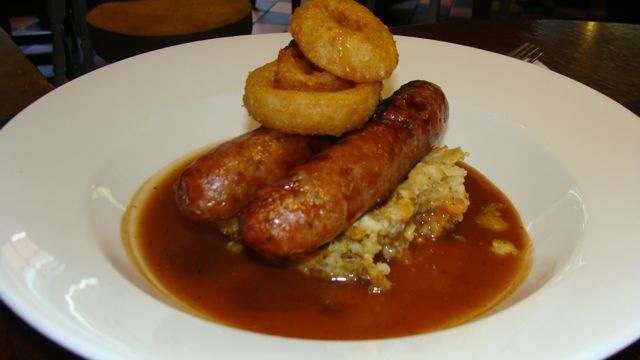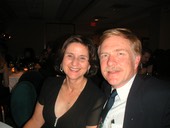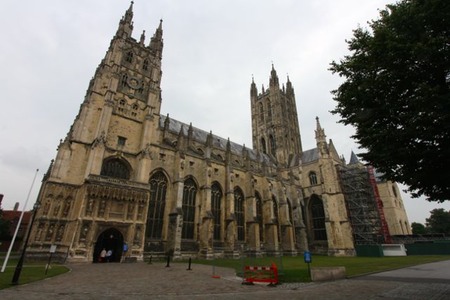
We spent Friday in Canterbury looking at the Cathedral and wandering around the city. The site of the Cathedral has had a church on it since about 597 AD when St. Augustine arrived as a missionary. The current building was started in 1070 AD a fire destroyed the existing building. St. Augustine was one of the first bishops of Canterbury. But, the Cathedral is most famous for being the site of the martyrdom of St. Thomas Becket in 1170 AD. Note that the angles look odd in the picture to the right because it was taken with a wide-angle lens. The Cathedral was a bit different in that it had multiple sections along the length. It was a beautiful building with much stained glass and statues.
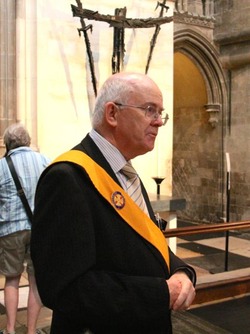
We wanted to see the room where Becket was killed so I asked one of the volunteers (picture on the right) where it was. I also asked him if the city and/or the Cathedral had suffered damage in the war. He proceeded to tell us about the war and then led us to the martyrdom site where he told us the whole story. It bears repeating.
Canterbury is only about 30 miles from France. During the war, the city was bombed over 100 times. Because they were so close, they often had no warning because the planes could come in close to the ground and avoid radar detection. There were instances of fighter planes using macing guns to mow down civilians on the streets. One night there was a massive raid on Canterbury where the Cathedral was the main target. This was apparently in retaliation for a massive Allied bombing raid on Cologne which destroyed the city. The Germans dropped many large bombs and numerous incendiary bombs. The idea was to destroy the buildings and then set them on fire. They were apparently not great shots because they destroyed a wide area just short of the Cathedral. The bishop had put people on the roofs of the buildings with shovels to get to the incendiary bombs and shovel them off the roof onto the ground where they could burn themselves out. One of the men reported that one of the large bombs missed the Cathedral by just 8 feet. There was apparently some divine protection for the building because there was no major damage to the structure. But large parts of the city were destroyed in the bombing.
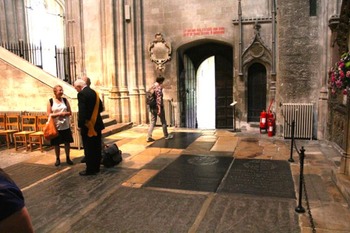
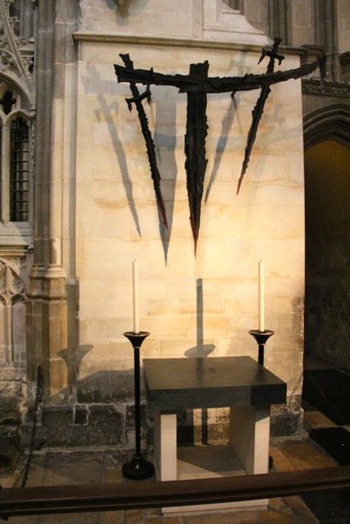
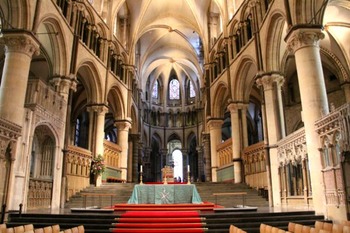
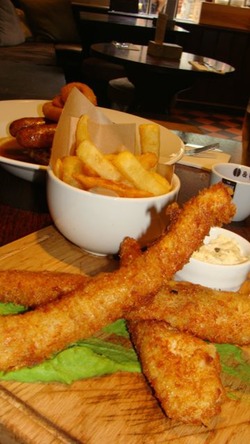
Thomas Becket was outspoken and not known for his tact. As a result he had annoyed the King who apparently uttered something like "Will no one rid me of this turbulent priest?" He probably didn’t mean it literally, but four knights over heard him and thought they would gain fame and honor if they would take care of Becket, so off they rode from London to Canterbury. When they arrived, some of the monks had warned Becket and brought him into the Cathedral and wanted him to lock the doors. He refused saying that the church needed to remain open so the people could come and pray. The knights entered through a side door (picture on right) from the Cloisters and serendipitously found Becket in a small room. They didn’t want to kill him a church and tried to drag him through the door. Becket was 6’2” tall, massive in that time and he resisted. He gave one of the knights a shove, and as a commoner, by touching a knight he committed a social faux pas that was punishable by death. One of the knights hit his head with the broad side of his sword knocking Becket to his knees. Then he attempted to decapitate him, but because he had drunk his lunch (according to our guide), he missed a bit and took the top of his skull off and his sword hit the floor and shattered. Another knight put the sharp end of his sword in Becket’s head and twisted it around making sure he was killed. Gruesome story which our guide delighted in telling us. Here is what a monk who tried to protect related it. "...The wicked knight leapt suddenly upon him, cutting off the top of the crown which the unction of sacred chrism had dedicated to God. Next he received a second blow on the head, but still he stood firm and immovable. At the third blow he fell on his knees and elbows, offering himself a living sacrifice, and saying in a low voice, 'For the name of Jesus and the protection of the Church, I am ready to embrace death.' But the third knight inflicted a terrible wound as he lay prostrate. By this stroke, the crown of his head was separated from the head in such a way that the blood white with the brain, and the brain no less red from the blood, dyed the floor of the cathedral. The same clerk who had entered with the knights placed his foot on the neck of the holy priest and precious martyr, and, horrible to relate, scattered the brains and blood about the pavements, crying to the others, 'Let us away, knights; this fellow will arise no more.” Becket was clearly dead and the monks in the church arrived to find him with blood all over the floor. They dipped their robes in his blood to make them selves holy as he was. Then they took off his robes and found his underclothes were made of hair. This was not underpants, but a garment that went from head to foot. Becket had not changed them for 7 years (all this according to our guide) and it was crawling with lice and fleas. The gathered monks tried to get lice and fleas to attach to their clothes on the theory that it might make them more holy.
The cross on the wall is a modern shrine to Becket. It is made to look like swords symbolizing how Becket died. In 1982, John Paul II and the Archbishop of Canterbury knelt in prayer at this spot in memory of Saint Thomas Becket.
We had lunch in a pub called the Shakespeare. Caroline had fish and chips. Chuck had farmer’s sausage on “bubbles and squeak”. I asked one of the staff what the origin of the name was. The dish is made of coarsely chopped leftover potatoes and vegetables and is a bit like a potato pancake. When it was cooked in a frying pan, it apparently bubbled and squeaked as it got hot—hence the name. It was actually quite good.
After wandering the city for bit, we headed back to our hideaway in the hills outside Dover to relax. It was a good day.
On the cruise ship tomorrow.
